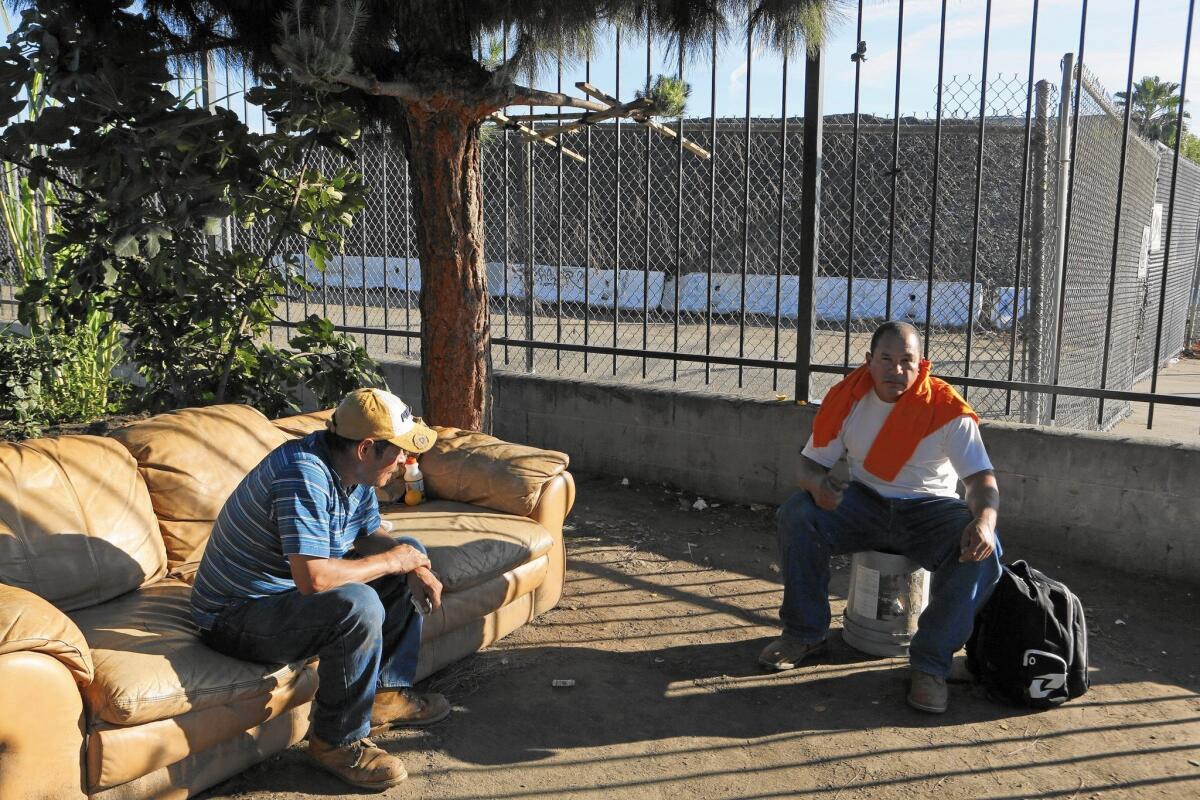30-foot pile of ground-up asphalt an eyesore, Lake Balboa residents say

- Share via
Joan Kelley always loved her view of the San Gabriel Mountains in the winter.
From the Lake Balboa house where she’s lived for five decades, she would often step outside just to see the peaks in the distance, sometimes dusted with snow.
But for the last year, Kelley’s only view has been of a mountain of a different sort: a 30-foot pile of asphalt on a city-owned lot across the street that spewed grit into her neighborhood any time the wind blew.
“It’s our mountain range, and it isn’t natural,” Kelley said. “You’d walk out and all you’d see is that ugly, black mountain.”
The mound sits behind a chain-link fence on a storage lot operated by the Los Angeles Bureau of Street Services on Balboa Place, adjacent to the Van Nuys Airport. On Wednesday, city workers covered the dusty hill with a white tarp, though it was too early to tell whether that will cut down the swirls of dust.
The rubble is the byproduct of aggressive street work throughout Los Angeles in which the surfaces of city roads are ground down and the crushed asphalt hauled to the city lot, where it sits until it can be recycled.
The catch is that the city uses only 20% recycled material when it heats up new asphalt, meaning the truckloads of asphalt are coming in quicker than they are going out, said Linda Serrato-Ybarra, a spokeswoman for Councilwoman Nury Martinez, who represents the district.
The Bureau of Street Services says it has been using the Lake Balboa lot for “recycling purposes in asphalt production” since the 1980s. But in recent months, a pile that once stood about 10 feet high has tripled in height and is 100 feet wide.
Martinez said the black pile is just the latest example of the environmental problems plaguing her San Fernando Valley district, which is dotted with landfills, waste processing facilities, junkyards and gravel pits — many of them near neighborhoods.
“It’s a constant battle trying to protect these neighborhoods from all of these hazards,” Martinez said.
“Sometimes I do get the feeling that this stuff ends up in my district and that for too long it’s been accepted by the bureaucracy that it’s OK to have these types of facilities in my district.... It’s unacceptable.”
When Megan and Tom Riordan moved to Lanark Street four years ago, they hardly noticed the pile across the street. But it caught their attention when it began to grow rapidly and fill the air with black grit.
Some days, Tom Riordan said, he had to hose down the storage shed in the couple’s backyard five times a day to keep the black dust from blowing inside their home and ruining filming equipment.
On a recent afternoon, his wife ran her finger along the inside of her window pane; it was covered in black grime. If she opened the living room windows on a windy day, she said, her furniture would be quickly coated.
She worries about the health effects of breathing air thick with asphalt.
“I want it gone,” she said. “It’s broken-down street — it doesn’t belong in a neighborhood, near people and their families.”
Last summer, Kelley complained to the South Coast Air Quality Management District about the mess, and inspectors were dispatched to the site — twice. But inspectors did not see any dust being kicked up during their visits and issued no citations, said Sam Atwood, the air district’s spokesman.
Last month, the Los Angeles City Council ordered Street Services to stop hauling in the pulverized asphalt, cover the pile, and figure out a permanent solution.
Kelley, 71, said it’s about time something is being done about the pile, which became such a spectacle that people drove into her neighborhood just to take photos of it.
Kelley said she complained to city officials for more than a year, to no avail.
“This is where we’ve raised our children and our animals. It’s the city’s problem, and they need to figure out how to do their jobs.”
Twitter: @haileybranson
More to Read
Sign up for Essential California
The most important California stories and recommendations in your inbox every morning.
You may occasionally receive promotional content from the Los Angeles Times.










